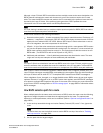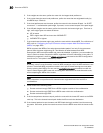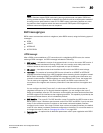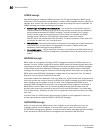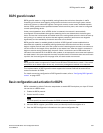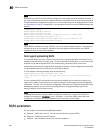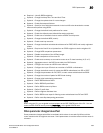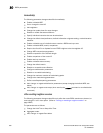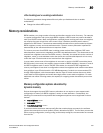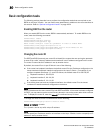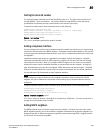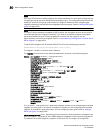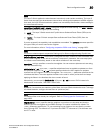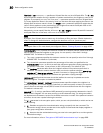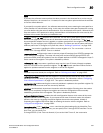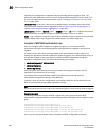
PowerConnect B-Series FCX Configuration Guide 991
53-1002266-01
Memory considerations
30
After disabling and re-enabling redistribution
The following parameter change takes effect only after you disable and then re-enable
redistribution:
• Change the default MED (metric).
Memory considerations
BGP4 handles a very large number of routes and therefore requires a lot of memory. For example,
in a typical configuration with just a single BGP4 neighbor, a BGP4 router may need to be able to
hold up to 80,000 routes. Many configurations, especially those involving more than one neighbor,
can require the router to hold even more routes. Layer 3 Switches provide dynamic memory
allocation for BGP4 data. These devices automatically allocate memory when needed to support
BGP4 neighbors, routes, and route attribute entries. Dynamic memory allocation is performed
automatically by the software and does not require a reload.
The memory amounts for all BGP4 data, including routes received from neighbors, BGP route
advertisements (routes sent to neighbors), and BGP route attribute entries. The routes sent to and
received from neighbors use the most BGP4 memory. Generally, the actual limit to the number of
neighbors, routes, or route attribute entries the device can accommodate depends on how many
routes the Layer 3 Switch sends to and receives from the neighbors.
In some cases, where most of the neighbors do not send or receive a full BGP route table (about
80,000 routes), the memory can support a larger number of BGP4 neighbors. However, if most of
the BGP4 neighbors send or receive full BGP route tables, the number of BGP neighbors the
memory can support is less than in configurations where the neighbors send smaller route tables.
As a guideline, Layer 3 Switches with a 512 MB Management 4 module can accommodate 150
through 200 neighbors, with the assumption that the Layer 3 Switch receives about one million
routes total from all neighbors and sends about eight million routes total to neighbors. For each
additional one million incoming routes, the capacity for outgoing routes decreases by around two
million.
Memory configuration options obsoleted by
dynamic memory
Devices that support dynamic BGP4 memory allocation do not require or even support static
configuration of memory for BGP4 neighbors, routes, or route attributes. Consequently, the
following CLI commands and equivalent Web management options are not supported on these
devices:
• max-neighbors <num>
• max-routes <num>
• max-attribute-entries <num>
If you boot a device that has a startup-config file that contains these commands, the software
ignores the commands and uses dynamic memory allocation for BGP4. The first time you save the
device running configuration (running-config) to the startup-config file, the commands are removed
from the file.



